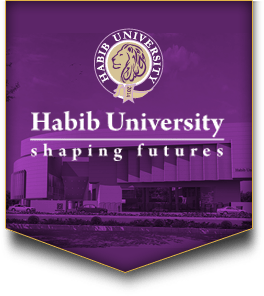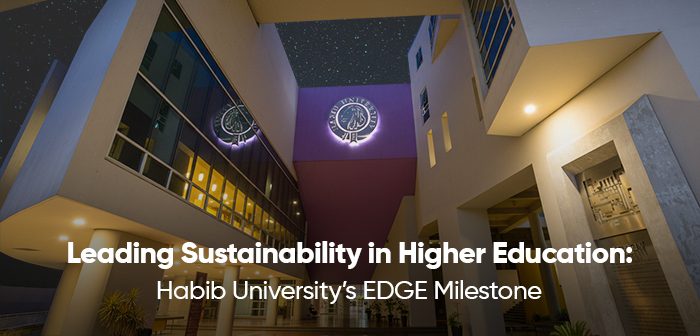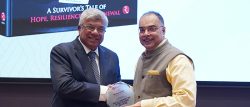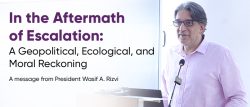A Global Milestone for a Green Campus
Habib University has become the first university in the South Asia, Middle East, Central Asia, and Turkey) region to receive the EDGE advanced certification from International Finance Corporation, a member of the World Bank Group, an internationally recognized green building certification system designed to make buildings more resource-efficient by leveraging local climate data, building type, and occupant behavior. This is a global recognition and testament to Habib University’s mission of sustainability, officially establishing it as a green campus.
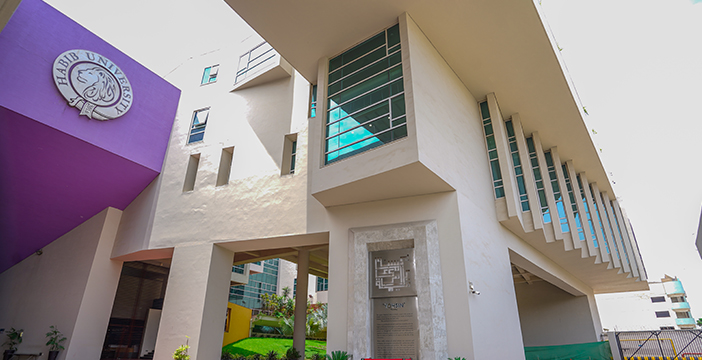
Building a Green Ecosystem in Pakistan
The EDGE (Excellence in Design for Greater Efficiencies) advanced certification is part of International Finance Corporation (IFC)’s broader efforts to develop a thriving green building ecosystem in Pakistan, under a climate-related blended finance initiative known as CIFPAK, in partnership with the UK Foreign, Commonwealth & Development Office (FCDO). The program supports policy reforms, private sector adoption, and awareness-building for sustainable construction. It is the IFC’s top-level recognition for resource-efficient buildings – certified projects show at least 40% on-site energy savings and strong reductions in water use and embodied carbon.
This achievement is not only a national milestone but also a regional first, underscoring Habib University’s role as a climate-conscious, future-ready institution committed to excellence in design, education, and sustainability.
Data That Defines a Green Campus
According to the official EDGE Assessment Report (2025) by Sintali Global, Habib University’s City Campus spans 45,740 square meters and has achieved the highest “EDGE Advanced” rating for education buildings.
The certification confirms:
• 48.01 % energy savings, 24.59 % water savings, and 100% embodied carbon reuse, meeting or exceeding all EDGE benchmarks.
• An estimated 1,942 tCO₂ of emissions are avoided annually, with total operational emissions now just 367 tCO₂ per year.
• 44.9 % of annual energy needs are supplied by on-site solar photovoltaics, backed by 10 % renewable procurement and carbon offsets.
• Efficiency features include reflective roofing and façades, natural ventilation, energy-efficient lighting (86 lm/W), smart metering, and low-flow water fixtures throughout the campus.
• The project achieves annual utility cost savings of PKR 44.8 million (≈ USD 161,000) with a 7.5-year payback period.
These measures are equivalent to powering 230 Pakistani households annually, saving water equal to 1,200 water tankers, and avoiding emissions equal to planting 2,200 trees and letting them grow for 10 years. With these results, Habib University becomes a demonstrable model for how existing educational infrastructure can transition to low-carbon operations while lowering costs and improving comfort for nearly 1,800 campus users each year.
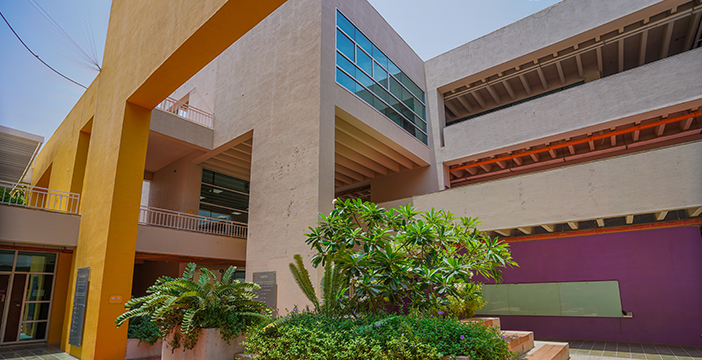
Climate Urgency and the Role of Universities
In a broader context, global emissions remain near record high (~53 Gt CO₂-eq in 2023), underscoring why rapid building – sector action is critical, according to the Emissions Database for Global Atmospheric Research. The Intergovernmental Panel on Climate Change (IPCC) continues to emphasize that rapid, deep cuts in greenhouse emissions are required across all sectors to avoid the worst impacts of climate change. Universities are highlighted as key sites for mitigation, research, and adaptation leadership. Moreover, buildings are a material part of emissions. When counting direct emissions and electricity use, the building sector represents a large share of global energy demand and related emissions. That means efficient building delivers measurable emission reductions and operational savings.
UNESCO and other organizations position universities as demonstrators of carbon-neutral pathways – campuses can accelerate local policy, workforce development, and green job creation. As buildings are a significant slice of energy consumption and emissions, a university campus that meets EDGE advanced criteria, like Habib University, becomes both a carbon-reduction asset and a living ecosystem of climate solutions.
Sustainability and Equity: Interconnected Goals
Global frameworks such as the UN’s sustainable development goals position climate action together with social equity – green transitions should create inclusive benefits (jobs, access to clean water, affordable energy) rather than deepen inequalities. SDG 10 aims to reduce inequality within and among countries. Universities, in this sense, are equitable actors that ensure benefits reach students, staff, and surrounding communities; UNESCO and UNDP note that universities have an obligation to support local development while decarbonizing.
Habib University’s sustainability agenda extends beyond energy efficiency; it is rooted in thoughtful service to humanity. The transformation of its City Campus demonstrates how environmental responsibility can also advance social equity. By lowering operational costs through efficient design and renewable generation, the University ensures that resources are redirected toward scholarships, research, and community outreach rather than utility expenses.
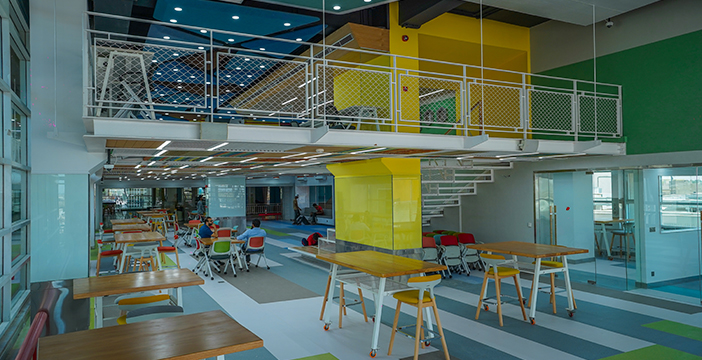
A Living Laboratory for Climate and Learning
The campus also functions as a workroom for sustainability education. Students and faculty collaborate on monitoring energy performance, water reuse, and carbon accounting, building local expertise in environmental engineering and sustainable development; fields critical for Pakistan’s resilience. In a city like Karachi, where environmental burdens are unevenly distributed, Habib’s model shows that green design can translate into cleaner air, lower heat stress, and a healthier, more inclusive learning environment.
Student Innovation Spotlight: IntelliCropPK
Beyond infrastructural achievements, Habib University’s commitment to sustainability is deeply educational. Its green campus serves as a living laboratory where students translate theory into real-world innovation.
An example is IntelliCropPK, a project by Computer Engineering alumni Nimra Sohail and Areeb Adnan Khan, guided by Dr. Tariq Kamal, Assistant Professor of Electrical & Computer Engineering. Selected from over 3,000 global applications across 100 countries for Prototypes for Humanity at COP 28 UAE, the project applied digital intelligence to strengthen climate resilience in Pakistan’s agriculture sector.
Supported through Habib University’s Graduate School Curation Program (GSCP) and its Summer Tehqiq Research Program (STRP), IntelliCropPK reflects how the University embeds climate-conscious thinking and social equity in its undergraduate research culture, cultivating innovators who see sustainability not only as an environmental goal, but as a humanitarian responsibility.
Climate in the Curriculum
This ethos of sustainability extends into Habib University’s classrooms. Faculty across disciplines engage students in understanding and responding to environmental challenges through a spectrum of courses that link science, society, and ethics. In the Integrated Sciences and Mathematics (ISciM) program, Abu Bakr Mehmood explores renewable energy systems; Hadiqa Maqsood examines Water: Science, Society, and Policy; Usman Salahuddin and Humaira Jamshed guide critical inquiries into climate science and scholarly communication.
Within the Comparative Humanities (CH) program, Syed Ali Mehdi Zaidi offers Anthropocene: An Introduction to Environmental Anthropology, prompting students to consider how human history and ecological change intertwine. In the Social Development and Policy (SDP) program, Dr. Aaron Mulvany’s A Social and Ethical History of Water, Farhan Anwar’s Urban Sustainability, and M. Aatir Khan’s Service Learning: Climate Change Awareness cultivates a multidisciplinary understanding of sustainability and justice.
Together, these courses form a pedagogical network that grounds Habib’s environmental philosophy in everyday teaching, ensuring that the green transformation of the campus is matched by a green transformation of thought.
A Blueprint for the Region
In a country facing water scarcity, energy insecurity, and urban heat extremes, the EDGE advanced certification signals that climate-conscious construction is both technically achievable and economically viable. By integrating renewable energy, efficient water systems, and material reuse, the University offers a replicable framework for other institutions, developers, and municipalities. The EDGE Advanced label, backed by the IFC and World Bank Group, positions Habib within a global network of climate-forward campuses, demonstrating how universities in the Global South can lead innovation rather than follow imported models.
“This milestone affirms Habib University’s resolve to ‘walk the talk’ of sustainability and epistemic reparation. It reflects our belief that institutions must lead not only in knowledge, but in conscience—creating models of learning that heal, regenerate, and sustain the world around them,” said quoted Habib University President, Wasif A. Rizvi.
“At Habib University, we’ve set a new standard in sustainable campus design with our EDGE Advanced Certification. This campus was built smart, built green, and built for the future, reflecting our commitment to climate-conscious infrastructure that serves generations to come,” said Azher Abbas, Head of Infrastructure, Planning, and Development at Habib University.
“By achieving EDGE Advanced Certification, Habib University has proven that sustainable, resource-efficient construction is not only achievable but also financially viable, even in dense urban centers like Karachi,” said Naz Khan, Country Manager for Pakistan and Afghanistan at IFC. “This achievement sets a powerful example for others, helping to accelerate green building and EDGE adoption across Pakistan. In doing so, we can protect the environment, lower operating costs, boost investment, and generate jobs throughout the supply chain.”
Looking Ahead: From Green Campus to Net Zero
The EDGE certification is not the culmination of Habib University’s green journey; it is a foundation. The institution plans to extend similar sustainability principles to future expansions, including greater renewable capacity and on-site energy storage. Building upon its success, the University is now exploring pathways toward net-zero carbon operations by integrating research, policy dialogue, and student-led innovation in clean energy and environmental design.
Habib University’s achievement challenges other educational institutions in Pakistan to reimagine their role in the climate transition; not limited to centers of knowledge, but as active prototypes of equitable, sustainable futures.
